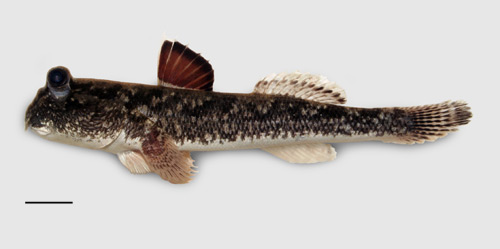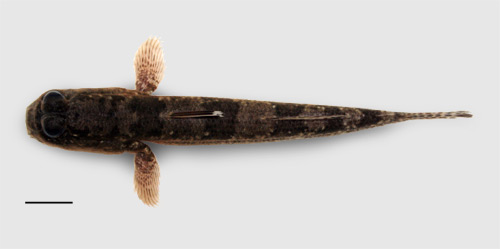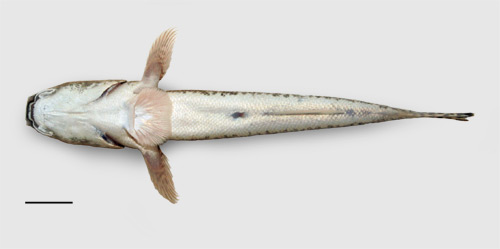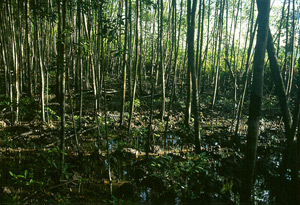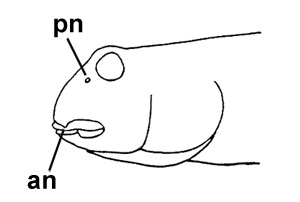|
Synonyms:
Etymology:
'Periophthalmus' is a compound name from the Greek 'peri' (around), and 'ophthalmôn' (eye), which refers to the wide visual field
of these species
the specific name is in commemoration of the tenth anniversary of the foundation of the Walailak University, Thailand
(Darumas & Tantichodok, 2002)
|
Maximum recorded length:
127 mm SL (Darumas & Tantichodok, 2002)
Live colouration (Darumas &
Tantichodok, 2002; Polgar & Khaironizam, 2008; pers. obs.: Thailand):
background colouration dorsally and laterally brownish, with numerous, irregular white to pale yellow speckles on flanks, cheeks and throat, as large as the exposed
field of the underlying scale. 4-7 diagonal, saddle like, dorsal and irregular dark bars; irregular black blotches on cheeks; short, irregular black stripe
frequently visible posteriorly to the orbit. Venter white. D1 proximally dark brown and black for the distal third; margin white. D2 with transparent
background, medial dark brown stripe and reddish margin in some individuals; 2-3 horizontal series of dark speckles on rays in some specimens; caudal
and pectoral fins background greyish, with series of dark brown speckles along rays; anal fin white; pelvic fins ventrally white, dorsally darker
Colouration on preservation (Darumas & Tantichodok, 2002;
Polgar & Khaironizam, 2008; pers. obs.: Thailand, India):
ground colour pale to dark brown dorsally and laterally, ventrally yellowish to greyish; irregular saddle
bars and darker or paler speckles and blotches may disappear after some time; D1 background completely dark brown, inframarginally darker and a
transparent margin; D2 background translucid with a dark
brown medial stripe, and 2-3 horizontal series of dark brown speckles on rays; caudal and pectoral fins background greyish, with series of dark
brown spots along rays, often disappearing on pectoral fins, but much more persistent on the caudal fin; anal and pelvic fins hyaline
Diagnosis (Polgar & Khaironizam, 2008 - Peninsular Malaysia; Jafaar et al., 2006:
Singapore; Darumas & Tantichodok, 2002 - Thailand; ranges include all datasets; see Remarks):
D1 VI-IX; longitudinal scale count 53-72; TRDB 10-20; head depth 14.3-22.9%SL; length of anal fin base 14.0-27.1%SL; length of D2 base 17.0-28.7%SL. D1 with neither stripes,
nor spots: completely dark brown with a white margin, which is transparent on preservation; rays of caudal and pectoral fins with series of dark brown speckles;
pelvic fins with a strong frenum and completely fused into a round disk.
The genus is yet undefined by synapomorphies
Diet:
carnivorous, opportunistic (crustaceans, insects, etc.:
Khaironizam & Norma-Rashid, 2002)
Reproduction:
it digs burrows 9-13 cm wide and 100-120 cm deep in the high mangrove forest (Darumas & Tantichodok, 2002, pers. obs.: Peninsular Malaysia); the details of its reproductive
cycle have not been described in literature: it probably follows the general model proposed for all
the congeneric species (see also Reproductive behaviour)
|
Ecological notes (pers. obs.: Peninsular Malaysia):
in mangrove forested areas, from the lower to the higher zone; its disruptive
colouration allows for efficient camouflage on the forest floor; there are descriptive accounts on a nocturnal behaviour in Thailand
(Darumas & Tantichodok, 2002); these observations
have not been confirmed by other authors in Peninsular Malaysia and Singapore (Jaafar et al., 2006; Polgar & Khaironizam, 2008); on the other hand, nocturnal behaviours had been described
in other congeneric species (e.g. P. argentilineatus and/or P. kalolo:
Colombini et. al., 1996)
left: Sementa, Malaysia: pioneer shore; few specimens of
P. walailakae were found here (photo: G. Polgar, 2007)
right: Kuala Selangor, Malaysia: high forest, nearby the reclamation bund; a reproductive male was found here inside its burrow (photo: G. Polgar, 1996)
|
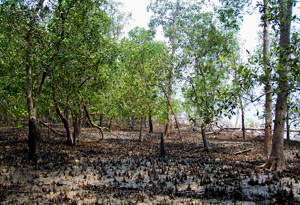
|
|
Remarks:
This species had been long misidentified as Periophthalmodon schlosseri, probably for the relatively large
size, the black stripes behind the orbits, and the dorsal fins' colouration
(Jaafar et al., 2006).
In the field, it can be discriminated from Periophthalmodon schlosseri by examination of the colouration of cheecks
and opercula: P. walailakae lacks the white-bluish, iridescent speckles present in the other species
(pers. obs.). The original description (Darumas & Tantichodok, 2002) probably includes some unreliable diagnostic characters (elements of D2 and anal fins:
Polgar & Khaironizam, 2008); the 1st spinous element of both D2 and anal fin is often small and closely approximated to the second one.
|
A: P. walailakae, a reproductive male into its burrow, in the high forest
(photo: G. Polgar; Kuala Selangor, Peninsular Malaysia, 1996); B: a close-up (photo: anonimous; Chek Jawa, Pulau Ubin, Singapore); C:
P. walailakae perching on a trunk of Sonneratia alba at low tide (photo: M.Z. Khaironizam,
1999); D: a specimen inside a plastic bag (photo: G. Polgar; Kukup Is., Peninsular Malaysia, 2007); E: the same specimen in D, ventral view (photo: G. Polgar; Kukup Is., Peninsular Malaysia, 2007); F: a specimen nearby the water edge (photo: Z. Pogonyi, Singapore, 2008)*; G: another specimen from Singapore; note the colouration of D2: a reproductive male? (photo: Ben Lee, Sg. Buloh, Singapore, 2007; Flickr, 2008)*; H, I: two interacting specimens (photo: R. Than, Singapore, 2008; Flickr [H; I], Wild Singapore, 2008)* - * with permission
|




